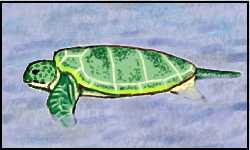|
|
|
|
|
|
SPECIES SPOTLIGHT
on

Chelonia mydas
| A.K.A. |
Green Turtle
|
| DESCRIPTION COLORATION |
The green turtle has a large heart-shaped marbled shell. Shell coloration is dark brown to olive. Their legs have evolved into strong flippers.
|
| SIZE |
This turtle is one of the largest sea turtles. They grow up to five feet in length. They may weigh up to 400 pounds.
|
| HOME |
This turtle may be found throughout all the warmer areas of all the oceans.
|
| HABITAT |
Warm shallow sea waters.
|
| LIFESTYLE |
This animal spends most of its time in the ocean. It lives a solitary lifestyle.
|
| PREDATORS |
Man has hunted this species for it's meat, eggs, and shell. Frigate birds will eat the eggs.
|
| FOOD |
Sea grass is a favorite food of adults as well as algae and mangrove leaves. Hatchling turtles feed on fish, crustaceans, jellyfish, and algae.
|
| BREEDING |
The breeding season is from October to February. Breeding takes place in the water. Females will nest every 2 to 4 years. Eggs are laid in beach rookeries. Many of these are located on Ascension Island. The turtles will migrate from as far as 2,800 miles away to reach their chosen beaches. Individual females will lay several clutches of eggs over a period of a few weeks. Each nest consists of approximately 100 eggs. The nest is a hole dug into the sand. Incubation at 82 degrees Fahrenheit will produce male turtles. Incubation at 90 degrees will result in female hatchlings. The eggs will hatch at night, 2 to 3 months after they are laid. The newly hatched turtles will then dig their way out of the nest and head for the sea. Only 1 or 2 out of 100 hatchlings will survive to reach 1 year of age.
|
| LIFE SPAN |
Up to 50 years.
|
| SPECIAL CONCERNS |
The Green Turtle has been hunted by man almost to extinction.
|
| INTERESTING FACTS |
Adults of this species have the ability to stay underwater without breathing for 5 hours.
|